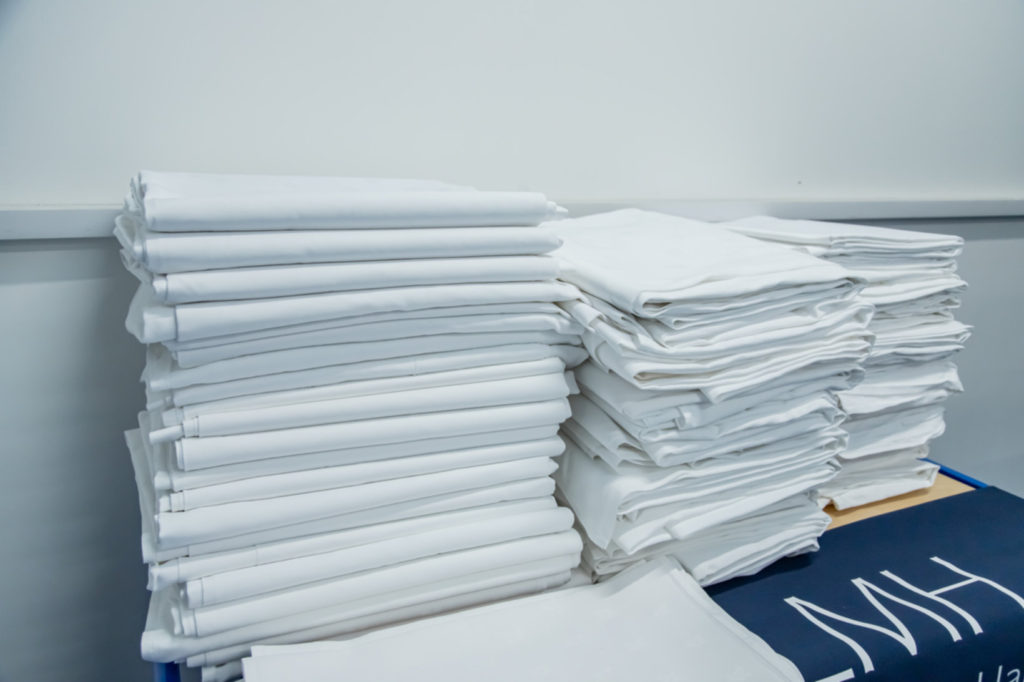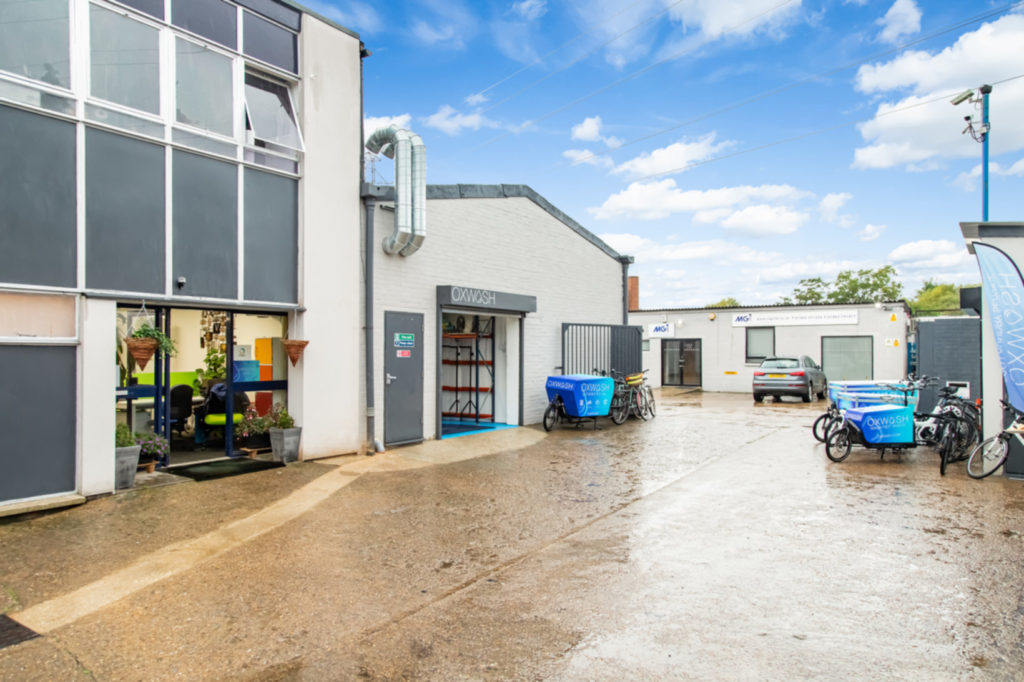The new Girbau washing and drying machines at OxWash. Pic: OxWash
Commercial laundries: Can Oxford’s new eco-laundry become a blueprint for the industry?
Oxford firm OXWASH would love its new eco-laundry in Oxford to turn the tide of the commercial laundry industry away from environmentally harmful practices. The renewably-powered facility is the UK’s first washing platform to use machines that recycle, filter and reuse water within the wash cycle. They also do away with harmful detergents, filter out microfibres and wash at the same temperature as a cold tap. Subsequent savings in costs, energy and improvements in fabric care make the economics of the facility appealing.
Ben Towler, commercial manager of OXWASH, talks TechTribe Oxford through the Osney Mead laundry and how the firm is competing in a £1bn industry that is price-sensitive and dominated by major players.
The four new washers and two driers were being installed when TechTribe Oxford visited OXWASH, just ahead of its official opening. To the uninitiated they look like regular machines, until you notice the large water tanks installed above each, as part of the new water reclamation system.
The tanks are used to recycle water during the wash cycle, filtering out dirt and microfibres at each stage, then reusing water that would have gone down the drain and been replenished with drinking-quality water from the mains.
“A traditional laundry uses water good enough for drinking, it washes then it goes down the drain. Here we are taking out what we don’t need, disposing of that, then reusing the water that is left,” says Towler, adding: “The circular process also gives us several bites of the cherry to filter out microfibres.”
OXWASH has worked closely with Spanish manufacturer Girbau to enhance machines that would achieve the eco-friendliness it wanted, to the same performance levels of conventional machines.
The ability to wash at lower temperatures is a critical requirement for any laundry facility wishing to reduce its energy use, and Towler confirms the machines get the same results at 20°C degrees as a conventional wash at 40-80°C.
“This not only helps reduce energy use, but fabrics last longer than they would when using harsh chemicals and higher temperatures,” he says.
Once the issue of lower temperature washes was resolved, Towler explains they looked for a solution which would create “the best overall effect,” in terms of lowering emissions and preventing the disposal of harmful chemicals and microfibres into the river system:
“If you can use something that isn’t organic but saves water and energy, and can be responsibly disposed of, the net result is better.”
Collecting and logging data on microfibres in the machines’ filters provides evidence of how much material would otherwise be going down the drain. “We know there are microfibres in the air and the sea, but we didn’t know how much is coming from laundry because we couldn’t trace it,” says Towler. “Now we can, as the filters show what would have gone through.”

Pic: Ian Walton for Virgin Money London Marathon
OXWASH is working with the organisers of the Virgin Money London Marathon to wash runners’ garments and gather data on the microfibres gleaned from them when they are washed.
Adjusting the dose and type of detergent for different types of wash is a key factor and the machines can be set to get the best out of each wash cycle. “Domestic powder is ‘one size fits all,’ whether it’s linen, socks or rugby kit, hard water or soft water, it’s all the same. Whereas here, we can specify dosage for each wash so it is as efficient, clean and waste-free as it can be,” he explains.
The textile services industry is making efforts to measure and improve its carbon footprint (see boxed item) and has embraced the UK Climate Agreement and the Climate Change Levy in cutting emissions overall. Towler observes that environmental responsibility is “new to laundry because up until now, no one’s really cared about it. Energy has been so cheap and while pollution has been known about, a lot of industries are happy to ignore it. As a business we’re not happy to do that.”
Customers are also becoming more aware of how firms are addressing their carbon footprints:
“People are increasingly conscious about it and cynical of ‘greenwash.’ We’re getting more calls asking how we are being more green and what does ‘eco laundry’ actually mean?”

Thomas de Wilton describes the new facility at the OXWASH opening. Pic: OXWASH
As a commercial enterprise, OXWASH is under constant pressure to compete in an industry which is price-sensitive and characterised by major players benefiting from economies of scale.
Yet Towler sees the economic models of conventional firms as outdated, heavy on road miles and low on quality: “The huge companies use a pool system, so they may collect in London, wash in Birmingham then transport linen for use in Liverpool. They also put bleach through everything regardless – taking so much out of the fabric.”
“Actually we are fairly competitive. Generally, we find if a customer was paying 20p per tea towel, with us they’d pay 25-30p and save the cost on the tea towel because it will last three to five times longer.”
OXWASH has a growing contingent of customers who run short lets and AirBnB’s, and when asked whether the firm will be raising its prices, Towler is clear: “No, they’ll still be paying the same rates. We’re quite young at the moment, so there are different things we may look into, such as having a pool stock of linen which we know we can get to last for much longer.”

Linen being laundered at OXWASH. Pic: OXWASH
Flexible service can give OXWASH the edge over large laundries, especially for short lets, Towler believes. “Most hotels are OK with a Monday to Monday laundry collection and delivery service, but AirBnB’s have different guests on different days. We can service these easily, because rather than take laundry from Oxford to London to Birmingham, for example, we’re taking it from Summertown to Osney Mead. That’s one-to-three road miles by cargo bike that can be any day of the week.”
OXWASH has affectionately dubbed the new facility ‘The Lagoon’ and now it’s up and running, Towler confirms it will continue to invest and innovate.
Wet cleaning for woollen suits is one example. This emerging practice is being used by menswear brands such as Boss in Germany, where dry cleaning is being phased out, due to the harm it does to the environment. “Wool will take water, but it takes time to get the shape and structure back,” explains Towler. “It’s more time-consuming but the outcome is better. It’s kinder to fabric, and garments will last longer.”
OXWASH considers the concept of laundry should apply to a wide variety of items beyond fabrics and is looking at washing take-away food containers in a potential tie-up with Deliveroo. Such a move could bring fast action to a part of the food industry that’s under big pressure to clean up its act when it comes to using and disposing of plastic.

The OXWASH facility at Osney Mead, Oxford. Pic: OXWASH
Commercial laundries and carbon emissions The UK laundry sector is worth around £1bn a year with more than 31,700 people employed across 3,700 businesses. Commercial laundries are used by hotels and restaurants, hospitals and care homes, gyms and fitness clubs, cruise ships, student accommodation and any company requiring specialised employee clothing or workwear. At an industry level, the Textile Services Association and has signed up to the UK Government’s Climate Change Agreement to reduce energy usage by 25 per cent by 2020. In February this year, it revealed that the industry had reduced its energy consumption by 19 per cent in the first two-year target period of the Climate Change Levy scheme (which offers tax rebates to firms reducing net energy consumption) and is on track for a further reduction of 24.12 per cent in the next two years. However this doesn’t differentiate between energy consumption of laundry, users versus commercial laundries. In 2011, research by its European Textile Services Association estimated the carbon emissions of a rental contract to supply hotel linen for one hotel room per year. It found that, on average, a hotel changes linen 200 times a year and the carbon emissions of a rental contract would be 90kg co2 (a London to Munich flight was measured at 127kg co2). Pic: Andrew Neel on Unsplash

